Project Report: Nestle's Recruitment, Selection, and Training
VerifiedAdded on 2021/02/20
|32
|6178
|61
Report
AI Summary
This report examines Nestle's strategies for recruitment, selection, and training in the context of global expansion. It begins with research goals and objectives, followed by a project management plan, including cost, scope, quality, time, communication, risk, and resources. The report then details the work breakdown structure (WBS) and Gantt chart for project management, along with a discussion of qualitative and quantitative investigations. Data analysis, interpretations, and recommendations are provided, culminating in a reflection on the research's value. The study aims to analyze how multinational organizations like Nestle can improve their recruitment, selection, and training methods to meet international requirements, with a focus on globalization, recruitment, training, and selection processes. The research incorporates both primary and secondary data collection methods to provide a comprehensive analysis of Nestle's practices and suggest improvements.

MANAGING A
SUCCESSFUL
BUSINESS
PROJECT
SUCCESSFUL
BUSINESS
PROJECT
Paraphrase This Document
Need a fresh take? Get an instant paraphrase of this document with our AI Paraphraser
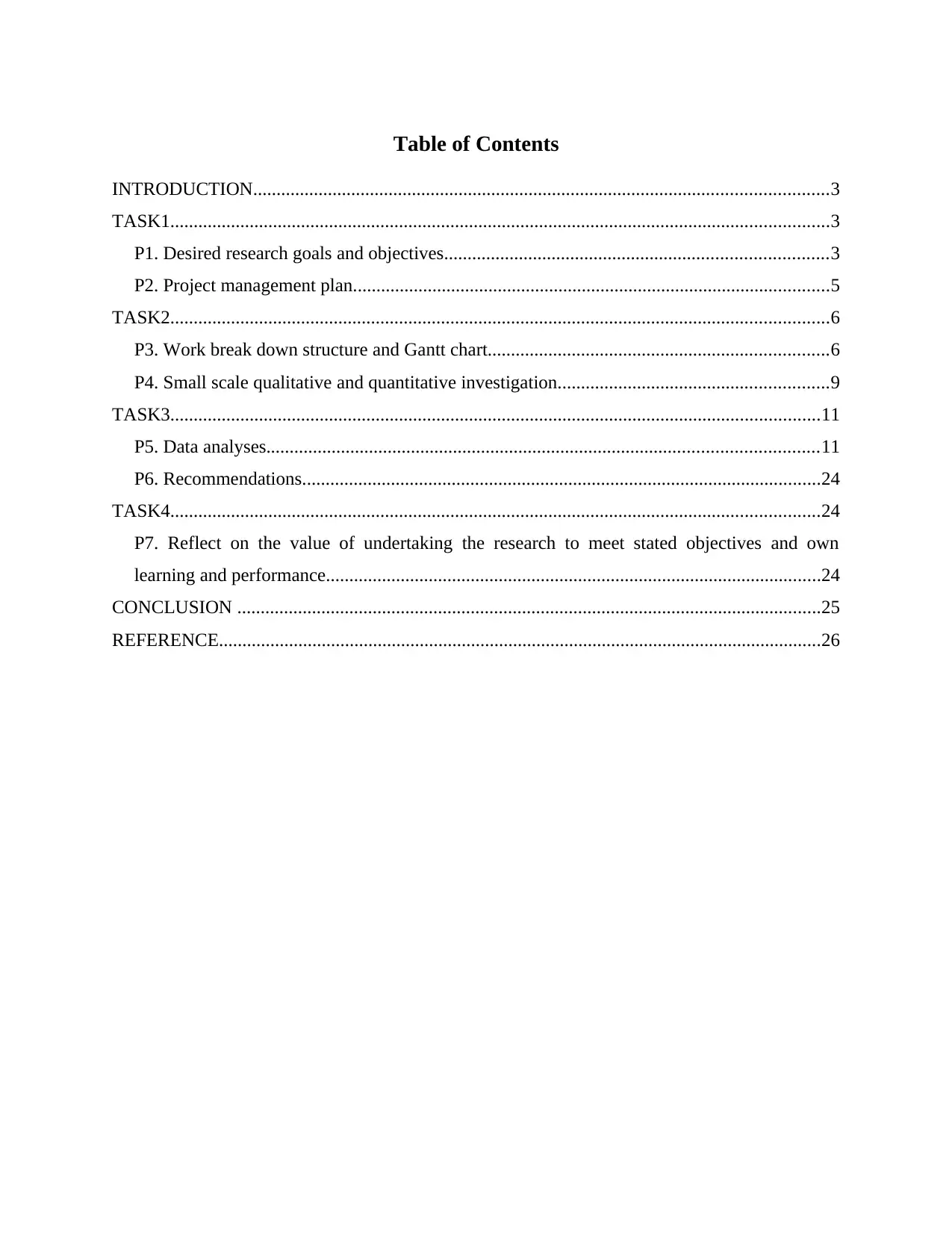
Table of Contents
INTRODUCTION...........................................................................................................................3
TASK1.............................................................................................................................................3
P1. Desired research goals and objectives..................................................................................3
P2. Project management plan......................................................................................................5
TASK2.............................................................................................................................................6
P3. Work break down structure and Gantt chart.........................................................................6
P4. Small scale qualitative and quantitative investigation..........................................................9
TASK3...........................................................................................................................................11
P5. Data analyses......................................................................................................................11
P6. Recommendations...............................................................................................................24
TASK4...........................................................................................................................................24
P7. Reflect on the value of undertaking the research to meet stated objectives and own
learning and performance..........................................................................................................24
CONCLUSION .............................................................................................................................25
REFERENCE.................................................................................................................................26
INTRODUCTION...........................................................................................................................3
TASK1.............................................................................................................................................3
P1. Desired research goals and objectives..................................................................................3
P2. Project management plan......................................................................................................5
TASK2.............................................................................................................................................6
P3. Work break down structure and Gantt chart.........................................................................6
P4. Small scale qualitative and quantitative investigation..........................................................9
TASK3...........................................................................................................................................11
P5. Data analyses......................................................................................................................11
P6. Recommendations...............................................................................................................24
TASK4...........................................................................................................................................24
P7. Reflect on the value of undertaking the research to meet stated objectives and own
learning and performance..........................................................................................................24
CONCLUSION .............................................................................................................................25
REFERENCE.................................................................................................................................26
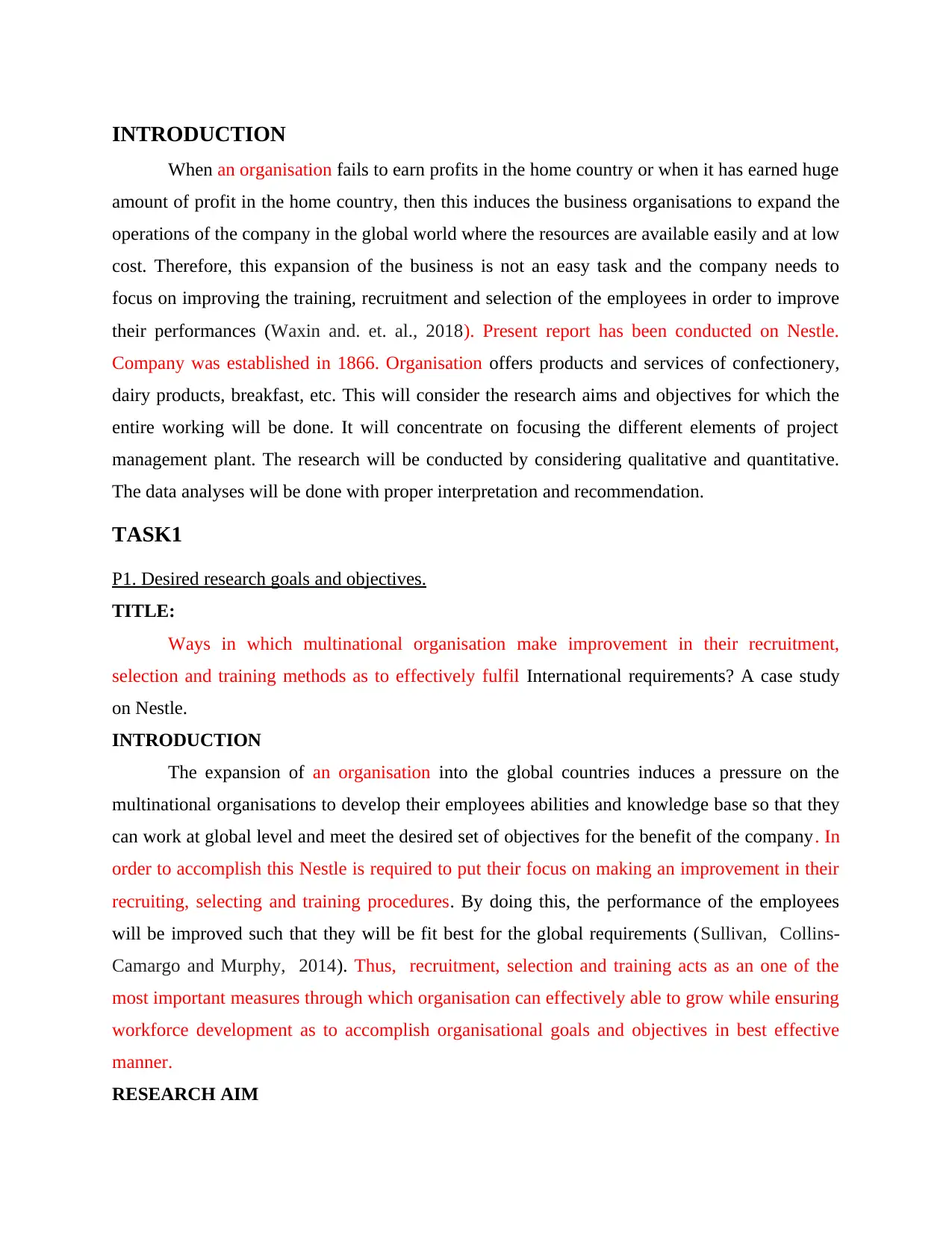
INTRODUCTION
When an organisation fails to earn profits in the home country or when it has earned huge
amount of profit in the home country, then this induces the business organisations to expand the
operations of the company in the global world where the resources are available easily and at low
cost. Therefore, this expansion of the business is not an easy task and the company needs to
focus on improving the training, recruitment and selection of the employees in order to improve
their performances (Waxin and. et. al., 2018). Present report has been conducted on Nestle.
Company was established in 1866. Organisation offers products and services of confectionery,
dairy products, breakfast, etc. This will consider the research aims and objectives for which the
entire working will be done. It will concentrate on focusing the different elements of project
management plant. The research will be conducted by considering qualitative and quantitative.
The data analyses will be done with proper interpretation and recommendation.
TASK1
P1. Desired research goals and objectives.
TITLE:
Ways in which multinational organisation make improvement in their recruitment,
selection and training methods as to effectively fulfil International requirements? A case study
on Nestle.
INTRODUCTION
The expansion of an organisation into the global countries induces a pressure on the
multinational organisations to develop their employees abilities and knowledge base so that they
can work at global level and meet the desired set of objectives for the benefit of the company. In
order to accomplish this Nestle is required to put their focus on making an improvement in their
recruiting, selecting and training procedures. By doing this, the performance of the employees
will be improved such that they will be fit best for the global requirements (Sullivan, Collins-
Camargo and Murphy, 2014). Thus, recruitment, selection and training acts as an one of the
most important measures through which organisation can effectively able to grow while ensuring
workforce development as to accomplish organisational goals and objectives in best effective
manner.
RESEARCH AIM
When an organisation fails to earn profits in the home country or when it has earned huge
amount of profit in the home country, then this induces the business organisations to expand the
operations of the company in the global world where the resources are available easily and at low
cost. Therefore, this expansion of the business is not an easy task and the company needs to
focus on improving the training, recruitment and selection of the employees in order to improve
their performances (Waxin and. et. al., 2018). Present report has been conducted on Nestle.
Company was established in 1866. Organisation offers products and services of confectionery,
dairy products, breakfast, etc. This will consider the research aims and objectives for which the
entire working will be done. It will concentrate on focusing the different elements of project
management plant. The research will be conducted by considering qualitative and quantitative.
The data analyses will be done with proper interpretation and recommendation.
TASK1
P1. Desired research goals and objectives.
TITLE:
Ways in which multinational organisation make improvement in their recruitment,
selection and training methods as to effectively fulfil International requirements? A case study
on Nestle.
INTRODUCTION
The expansion of an organisation into the global countries induces a pressure on the
multinational organisations to develop their employees abilities and knowledge base so that they
can work at global level and meet the desired set of objectives for the benefit of the company. In
order to accomplish this Nestle is required to put their focus on making an improvement in their
recruiting, selecting and training procedures. By doing this, the performance of the employees
will be improved such that they will be fit best for the global requirements (Sullivan, Collins-
Camargo and Murphy, 2014). Thus, recruitment, selection and training acts as an one of the
most important measures through which organisation can effectively able to grow while ensuring
workforce development as to accomplish organisational goals and objectives in best effective
manner.
RESEARCH AIM
⊘ This is a preview!⊘
Do you want full access?
Subscribe today to unlock all pages.

Trusted by 1+ million students worldwide
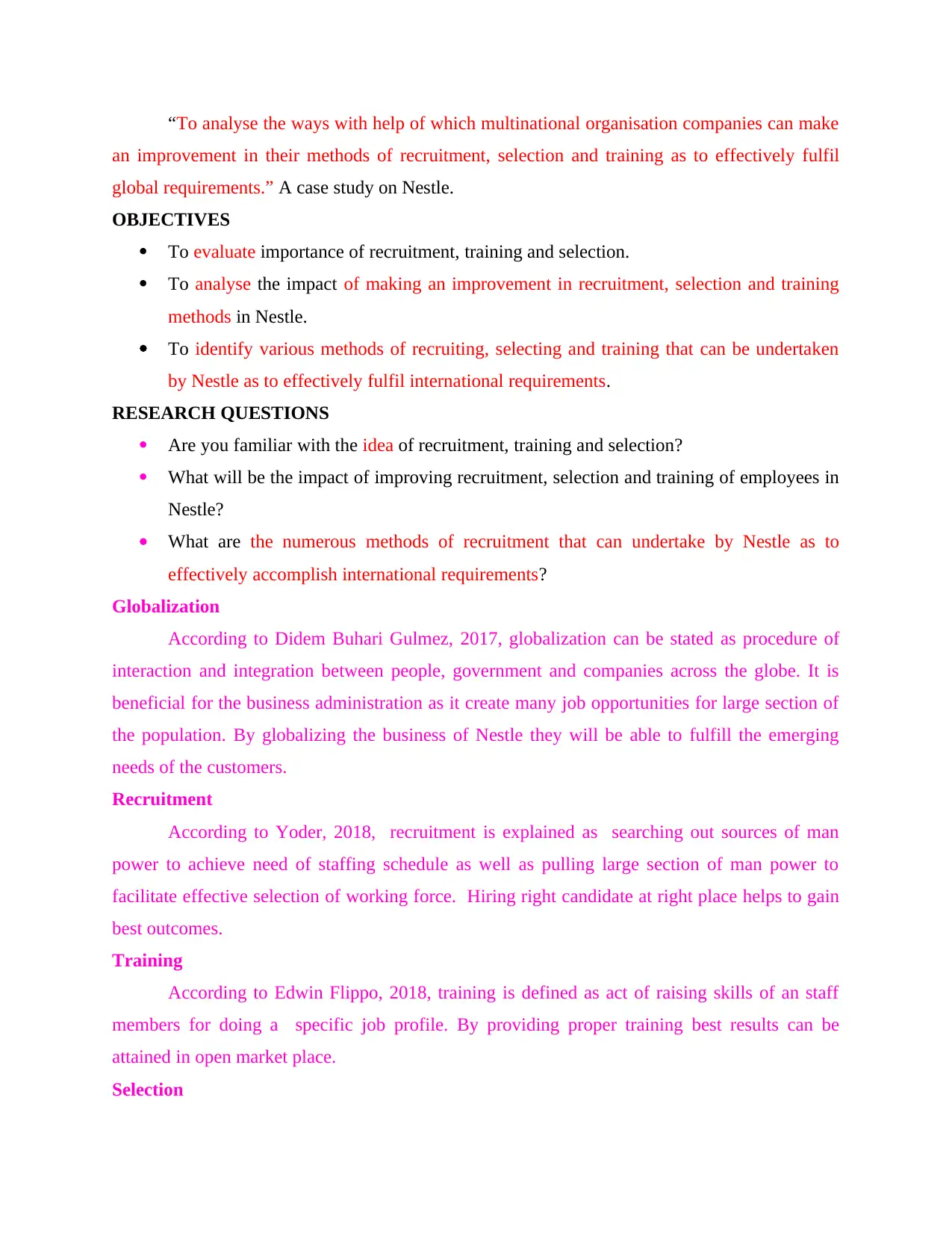
“To analyse the ways with help of which multinational organisation companies can make
an improvement in their methods of recruitment, selection and training as to effectively fulfil
global requirements.” A case study on Nestle.
OBJECTIVES
To evaluate importance of recruitment, training and selection.
To analyse the impact of making an improvement in recruitment, selection and training
methods in Nestle.
To identify various methods of recruiting, selecting and training that can be undertaken
by Nestle as to effectively fulfil international requirements.
RESEARCH QUESTIONS
Are you familiar with the idea of recruitment, training and selection?
What will be the impact of improving recruitment, selection and training of employees in
Nestle?
What are the numerous methods of recruitment that can undertake by Nestle as to
effectively accomplish international requirements?
Globalization
According to Didem Buhari Gulmez, 2017, globalization can be stated as procedure of
interaction and integration between people, government and companies across the globe. It is
beneficial for the business administration as it create many job opportunities for large section of
the population. By globalizing the business of Nestle they will be able to fulfill the emerging
needs of the customers.
Recruitment
According to Yoder, 2018, recruitment is explained as searching out sources of man
power to achieve need of staffing schedule as well as pulling large section of man power to
facilitate effective selection of working force. Hiring right candidate at right place helps to gain
best outcomes.
Training
According to Edwin Flippo, 2018, training is defined as act of raising skills of an staff
members for doing a specific job profile. By providing proper training best results can be
attained in open market place.
Selection
an improvement in their methods of recruitment, selection and training as to effectively fulfil
global requirements.” A case study on Nestle.
OBJECTIVES
To evaluate importance of recruitment, training and selection.
To analyse the impact of making an improvement in recruitment, selection and training
methods in Nestle.
To identify various methods of recruiting, selecting and training that can be undertaken
by Nestle as to effectively fulfil international requirements.
RESEARCH QUESTIONS
Are you familiar with the idea of recruitment, training and selection?
What will be the impact of improving recruitment, selection and training of employees in
Nestle?
What are the numerous methods of recruitment that can undertake by Nestle as to
effectively accomplish international requirements?
Globalization
According to Didem Buhari Gulmez, 2017, globalization can be stated as procedure of
interaction and integration between people, government and companies across the globe. It is
beneficial for the business administration as it create many job opportunities for large section of
the population. By globalizing the business of Nestle they will be able to fulfill the emerging
needs of the customers.
Recruitment
According to Yoder, 2018, recruitment is explained as searching out sources of man
power to achieve need of staffing schedule as well as pulling large section of man power to
facilitate effective selection of working force. Hiring right candidate at right place helps to gain
best outcomes.
Training
According to Edwin Flippo, 2018, training is defined as act of raising skills of an staff
members for doing a specific job profile. By providing proper training best results can be
attained in open market place.
Selection
Paraphrase This Document
Need a fresh take? Get an instant paraphrase of this document with our AI Paraphraser
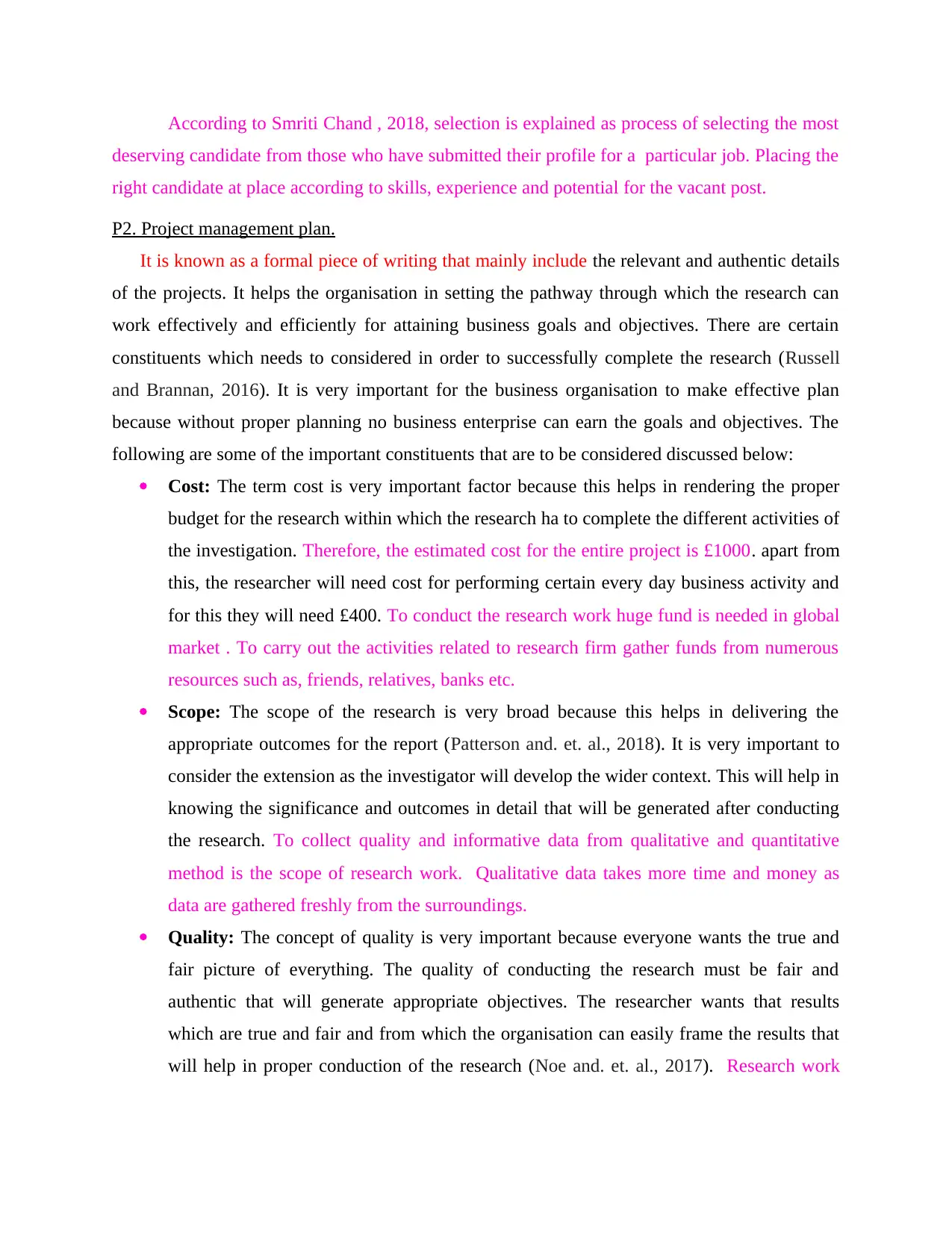
According to Smriti Chand , 2018, selection is explained as process of selecting the most
deserving candidate from those who have submitted their profile for a particular job. Placing the
right candidate at place according to skills, experience and potential for the vacant post.
P2. Project management plan.
It is known as a formal piece of writing that mainly include the relevant and authentic details
of the projects. It helps the organisation in setting the pathway through which the research can
work effectively and efficiently for attaining business goals and objectives. There are certain
constituents which needs to considered in order to successfully complete the research (Russell
and Brannan, 2016). It is very important for the business organisation to make effective plan
because without proper planning no business enterprise can earn the goals and objectives. The
following are some of the important constituents that are to be considered discussed below:
Cost: The term cost is very important factor because this helps in rendering the proper
budget for the research within which the research ha to complete the different activities of
the investigation. Therefore, the estimated cost for the entire project is £1000. apart from
this, the researcher will need cost for performing certain every day business activity and
for this they will need £400. To conduct the research work huge fund is needed in global
market . To carry out the activities related to research firm gather funds from numerous
resources such as, friends, relatives, banks etc.
Scope: The scope of the research is very broad because this helps in delivering the
appropriate outcomes for the report (Patterson and. et. al., 2018). It is very important to
consider the extension as the investigator will develop the wider context. This will help in
knowing the significance and outcomes in detail that will be generated after conducting
the research. To collect quality and informative data from qualitative and quantitative
method is the scope of research work. Qualitative data takes more time and money as
data are gathered freshly from the surroundings.
Quality: The concept of quality is very important because everyone wants the true and
fair picture of everything. The quality of conducting the research must be fair and
authentic that will generate appropriate objectives. The researcher wants that results
which are true and fair and from which the organisation can easily frame the results that
will help in proper conduction of the research (Noe and. et. al., 2017). Research work
deserving candidate from those who have submitted their profile for a particular job. Placing the
right candidate at place according to skills, experience and potential for the vacant post.
P2. Project management plan.
It is known as a formal piece of writing that mainly include the relevant and authentic details
of the projects. It helps the organisation in setting the pathway through which the research can
work effectively and efficiently for attaining business goals and objectives. There are certain
constituents which needs to considered in order to successfully complete the research (Russell
and Brannan, 2016). It is very important for the business organisation to make effective plan
because without proper planning no business enterprise can earn the goals and objectives. The
following are some of the important constituents that are to be considered discussed below:
Cost: The term cost is very important factor because this helps in rendering the proper
budget for the research within which the research ha to complete the different activities of
the investigation. Therefore, the estimated cost for the entire project is £1000. apart from
this, the researcher will need cost for performing certain every day business activity and
for this they will need £400. To conduct the research work huge fund is needed in global
market . To carry out the activities related to research firm gather funds from numerous
resources such as, friends, relatives, banks etc.
Scope: The scope of the research is very broad because this helps in delivering the
appropriate outcomes for the report (Patterson and. et. al., 2018). It is very important to
consider the extension as the investigator will develop the wider context. This will help in
knowing the significance and outcomes in detail that will be generated after conducting
the research. To collect quality and informative data from qualitative and quantitative
method is the scope of research work. Qualitative data takes more time and money as
data are gathered freshly from the surroundings.
Quality: The concept of quality is very important because everyone wants the true and
fair picture of everything. The quality of conducting the research must be fair and
authentic that will generate appropriate objectives. The researcher wants that results
which are true and fair and from which the organisation can easily frame the results that
will help in proper conduction of the research (Noe and. et. al., 2017). Research work
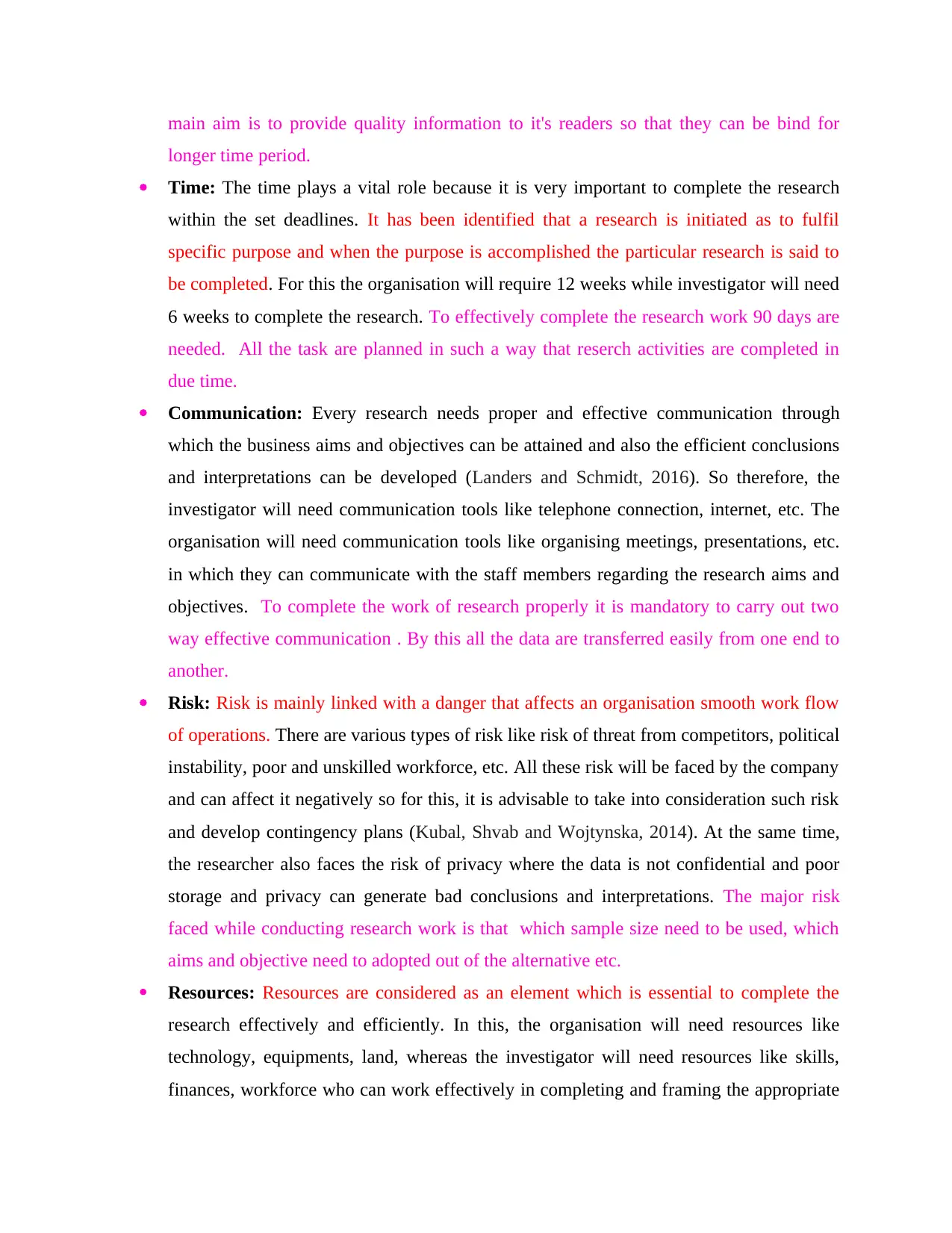
main aim is to provide quality information to it's readers so that they can be bind for
longer time period.
Time: The time plays a vital role because it is very important to complete the research
within the set deadlines. It has been identified that a research is initiated as to fulfil
specific purpose and when the purpose is accomplished the particular research is said to
be completed. For this the organisation will require 12 weeks while investigator will need
6 weeks to complete the research. To effectively complete the research work 90 days are
needed. All the task are planned in such a way that reserch activities are completed in
due time.
Communication: Every research needs proper and effective communication through
which the business aims and objectives can be attained and also the efficient conclusions
and interpretations can be developed (Landers and Schmidt, 2016). So therefore, the
investigator will need communication tools like telephone connection, internet, etc. The
organisation will need communication tools like organising meetings, presentations, etc.
in which they can communicate with the staff members regarding the research aims and
objectives. To complete the work of research properly it is mandatory to carry out two
way effective communication . By this all the data are transferred easily from one end to
another.
Risk: Risk is mainly linked with a danger that affects an organisation smooth work flow
of operations. There are various types of risk like risk of threat from competitors, political
instability, poor and unskilled workforce, etc. All these risk will be faced by the company
and can affect it negatively so for this, it is advisable to take into consideration such risk
and develop contingency plans (Kubal, Shvab and Wojtynska, 2014). At the same time,
the researcher also faces the risk of privacy where the data is not confidential and poor
storage and privacy can generate bad conclusions and interpretations. The major risk
faced while conducting research work is that which sample size need to be used, which
aims and objective need to adopted out of the alternative etc.
Resources: Resources are considered as an element which is essential to complete the
research effectively and efficiently. In this, the organisation will need resources like
technology, equipments, land, whereas the investigator will need resources like skills,
finances, workforce who can work effectively in completing and framing the appropriate
longer time period.
Time: The time plays a vital role because it is very important to complete the research
within the set deadlines. It has been identified that a research is initiated as to fulfil
specific purpose and when the purpose is accomplished the particular research is said to
be completed. For this the organisation will require 12 weeks while investigator will need
6 weeks to complete the research. To effectively complete the research work 90 days are
needed. All the task are planned in such a way that reserch activities are completed in
due time.
Communication: Every research needs proper and effective communication through
which the business aims and objectives can be attained and also the efficient conclusions
and interpretations can be developed (Landers and Schmidt, 2016). So therefore, the
investigator will need communication tools like telephone connection, internet, etc. The
organisation will need communication tools like organising meetings, presentations, etc.
in which they can communicate with the staff members regarding the research aims and
objectives. To complete the work of research properly it is mandatory to carry out two
way effective communication . By this all the data are transferred easily from one end to
another.
Risk: Risk is mainly linked with a danger that affects an organisation smooth work flow
of operations. There are various types of risk like risk of threat from competitors, political
instability, poor and unskilled workforce, etc. All these risk will be faced by the company
and can affect it negatively so for this, it is advisable to take into consideration such risk
and develop contingency plans (Kubal, Shvab and Wojtynska, 2014). At the same time,
the researcher also faces the risk of privacy where the data is not confidential and poor
storage and privacy can generate bad conclusions and interpretations. The major risk
faced while conducting research work is that which sample size need to be used, which
aims and objective need to adopted out of the alternative etc.
Resources: Resources are considered as an element which is essential to complete the
research effectively and efficiently. In this, the organisation will need resources like
technology, equipments, land, whereas the investigator will need resources like skills,
finances, workforce who can work effectively in completing and framing the appropriate
⊘ This is a preview!⊘
Do you want full access?
Subscribe today to unlock all pages.

Trusted by 1+ million students worldwide
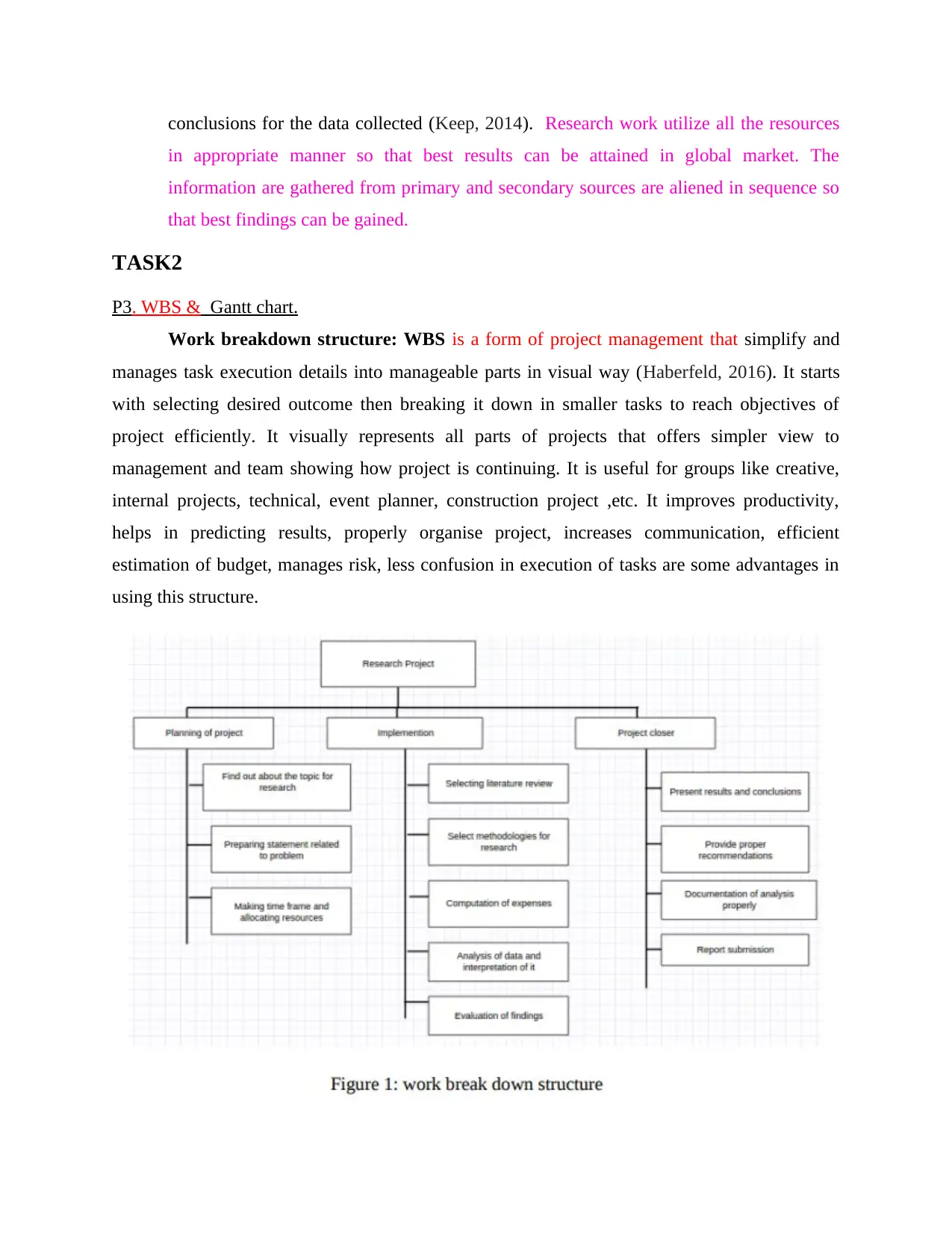
conclusions for the data collected (Keep, 2014). Research work utilize all the resources
in appropriate manner so that best results can be attained in global market. The
information are gathered from primary and secondary sources are aliened in sequence so
that best findings can be gained.
TASK2
P3. WBS & Gantt chart.
Work breakdown structure: WBS is a form of project management that simplify and
manages task execution details into manageable parts in visual way (Haberfeld, 2016). It starts
with selecting desired outcome then breaking it down in smaller tasks to reach objectives of
project efficiently. It visually represents all parts of projects that offers simpler view to
management and team showing how project is continuing. It is useful for groups like creative,
internal projects, technical, event planner, construction project ,etc. It improves productivity,
helps in predicting results, properly organise project, increases communication, efficient
estimation of budget, manages risk, less confusion in execution of tasks are some advantages in
using this structure.
in appropriate manner so that best results can be attained in global market. The
information are gathered from primary and secondary sources are aliened in sequence so
that best findings can be gained.
TASK2
P3. WBS & Gantt chart.
Work breakdown structure: WBS is a form of project management that simplify and
manages task execution details into manageable parts in visual way (Haberfeld, 2016). It starts
with selecting desired outcome then breaking it down in smaller tasks to reach objectives of
project efficiently. It visually represents all parts of projects that offers simpler view to
management and team showing how project is continuing. It is useful for groups like creative,
internal projects, technical, event planner, construction project ,etc. It improves productivity,
helps in predicting results, properly organise project, increases communication, efficient
estimation of budget, manages risk, less confusion in execution of tasks are some advantages in
using this structure.
Paraphrase This Document
Need a fresh take? Get an instant paraphrase of this document with our AI Paraphraser
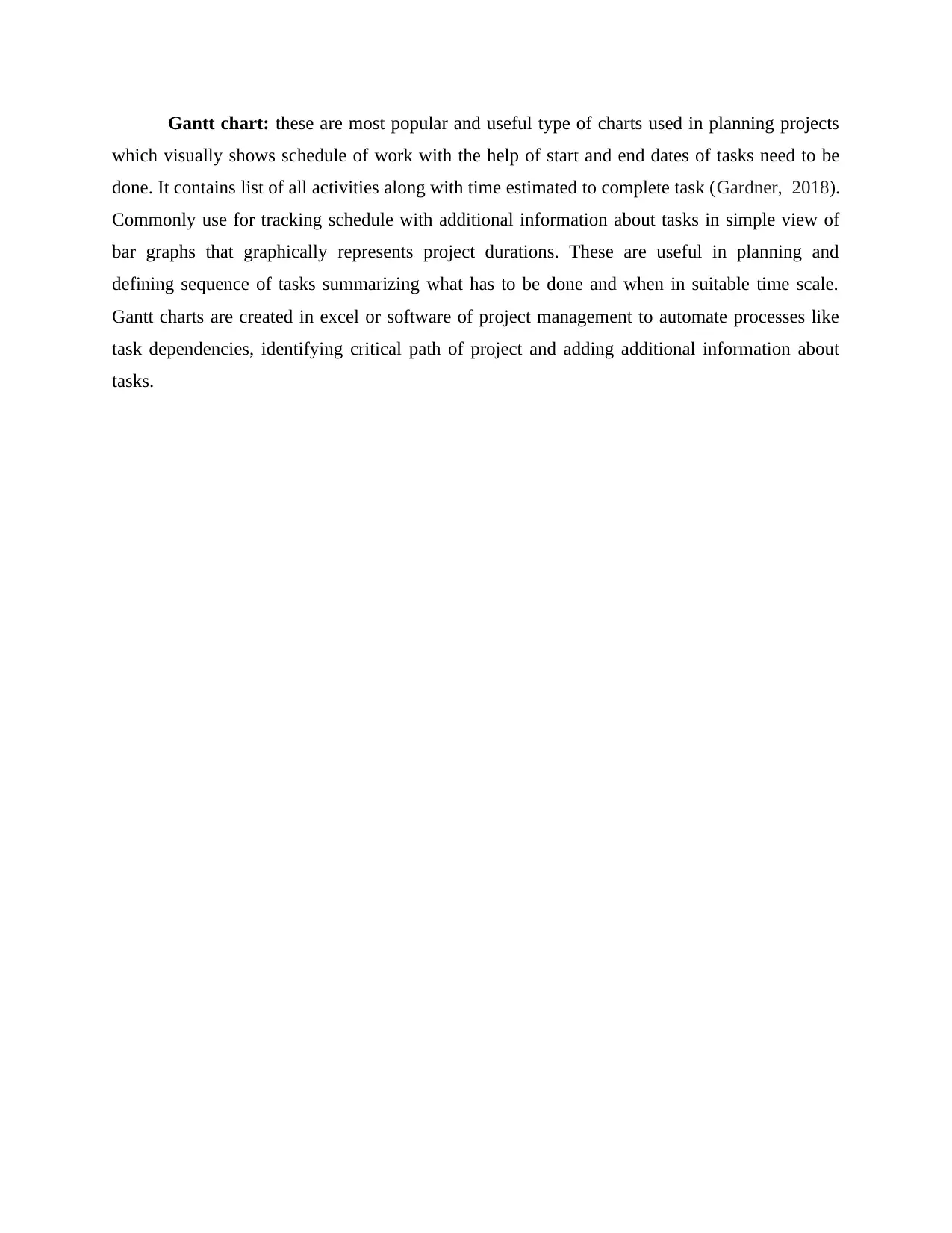
Gantt chart: these are most popular and useful type of charts used in planning projects
which visually shows schedule of work with the help of start and end dates of tasks need to be
done. It contains list of all activities along with time estimated to complete task (Gardner, 2018).
Commonly use for tracking schedule with additional information about tasks in simple view of
bar graphs that graphically represents project durations. These are useful in planning and
defining sequence of tasks summarizing what has to be done and when in suitable time scale.
Gantt charts are created in excel or software of project management to automate processes like
task dependencies, identifying critical path of project and adding additional information about
tasks.
which visually shows schedule of work with the help of start and end dates of tasks need to be
done. It contains list of all activities along with time estimated to complete task (Gardner, 2018).
Commonly use for tracking schedule with additional information about tasks in simple view of
bar graphs that graphically represents project durations. These are useful in planning and
defining sequence of tasks summarizing what has to be done and when in suitable time scale.
Gantt charts are created in excel or software of project management to automate processes like
task dependencies, identifying critical path of project and adding additional information about
tasks.
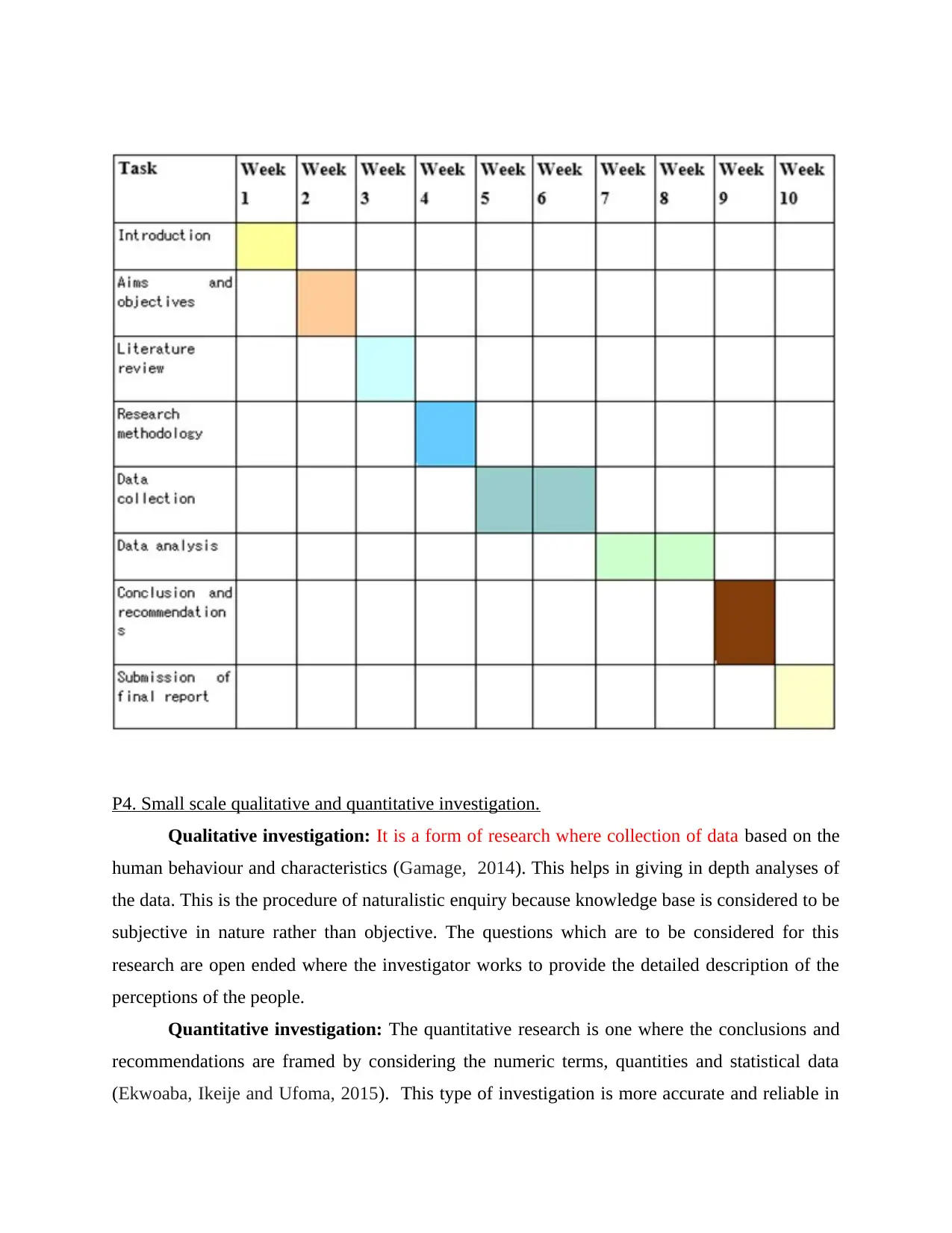
P4. Small scale qualitative and quantitative investigation.
Qualitative investigation: It is a form of research where collection of data based on the
human behaviour and characteristics (Gamage, 2014). This helps in giving in depth analyses of
the data. This is the procedure of naturalistic enquiry because knowledge base is considered to be
subjective in nature rather than objective. The questions which are to be considered for this
research are open ended where the investigator works to provide the detailed description of the
perceptions of the people.
Quantitative investigation: The quantitative research is one where the conclusions and
recommendations are framed by considering the numeric terms, quantities and statistical data
(Ekwoaba, Ikeije and Ufoma, 2015). This type of investigation is more accurate and reliable in
Qualitative investigation: It is a form of research where collection of data based on the
human behaviour and characteristics (Gamage, 2014). This helps in giving in depth analyses of
the data. This is the procedure of naturalistic enquiry because knowledge base is considered to be
subjective in nature rather than objective. The questions which are to be considered for this
research are open ended where the investigator works to provide the detailed description of the
perceptions of the people.
Quantitative investigation: The quantitative research is one where the conclusions and
recommendations are framed by considering the numeric terms, quantities and statistical data
(Ekwoaba, Ikeije and Ufoma, 2015). This type of investigation is more accurate and reliable in
⊘ This is a preview!⊘
Do you want full access?
Subscribe today to unlock all pages.

Trusted by 1+ million students worldwide
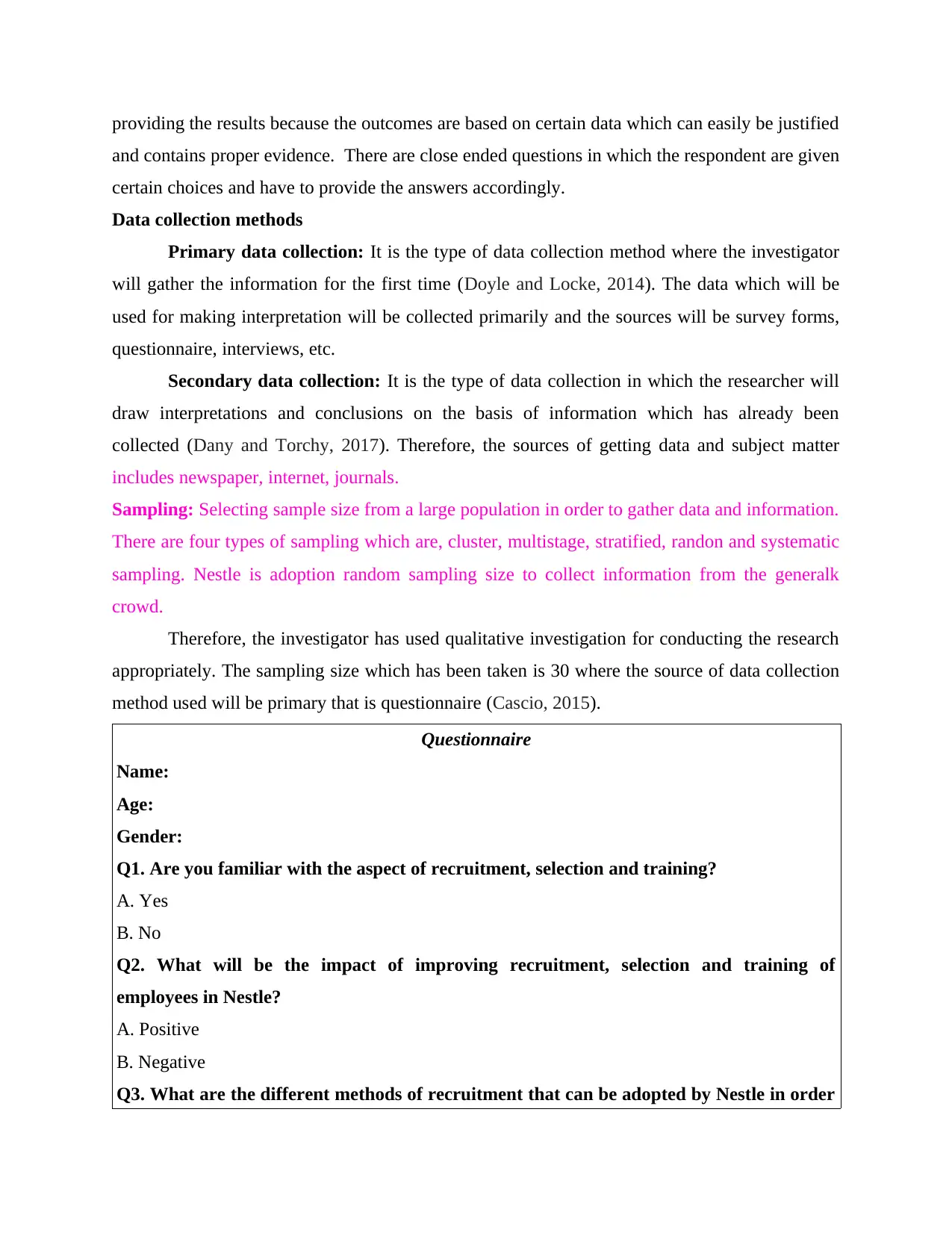
providing the results because the outcomes are based on certain data which can easily be justified
and contains proper evidence. There are close ended questions in which the respondent are given
certain choices and have to provide the answers accordingly.
Data collection methods
Primary data collection: It is the type of data collection method where the investigator
will gather the information for the first time (Doyle and Locke, 2014). The data which will be
used for making interpretation will be collected primarily and the sources will be survey forms,
questionnaire, interviews, etc.
Secondary data collection: It is the type of data collection in which the researcher will
draw interpretations and conclusions on the basis of information which has already been
collected (Dany and Torchy, 2017). Therefore, the sources of getting data and subject matter
includes newspaper, internet, journals.
Sampling: Selecting sample size from a large population in order to gather data and information.
There are four types of sampling which are, cluster, multistage, stratified, randon and systematic
sampling. Nestle is adoption random sampling size to collect information from the generalk
crowd.
Therefore, the investigator has used qualitative investigation for conducting the research
appropriately. The sampling size which has been taken is 30 where the source of data collection
method used will be primary that is questionnaire (Cascio, 2015).
Questionnaire
Name:
Age:
Gender:
Q1. Are you familiar with the aspect of recruitment, selection and training?
A. Yes
B. No
Q2. What will be the impact of improving recruitment, selection and training of
employees in Nestle?
A. Positive
B. Negative
Q3. What are the different methods of recruitment that can be adopted by Nestle in order
and contains proper evidence. There are close ended questions in which the respondent are given
certain choices and have to provide the answers accordingly.
Data collection methods
Primary data collection: It is the type of data collection method where the investigator
will gather the information for the first time (Doyle and Locke, 2014). The data which will be
used for making interpretation will be collected primarily and the sources will be survey forms,
questionnaire, interviews, etc.
Secondary data collection: It is the type of data collection in which the researcher will
draw interpretations and conclusions on the basis of information which has already been
collected (Dany and Torchy, 2017). Therefore, the sources of getting data and subject matter
includes newspaper, internet, journals.
Sampling: Selecting sample size from a large population in order to gather data and information.
There are four types of sampling which are, cluster, multistage, stratified, randon and systematic
sampling. Nestle is adoption random sampling size to collect information from the generalk
crowd.
Therefore, the investigator has used qualitative investigation for conducting the research
appropriately. The sampling size which has been taken is 30 where the source of data collection
method used will be primary that is questionnaire (Cascio, 2015).
Questionnaire
Name:
Age:
Gender:
Q1. Are you familiar with the aspect of recruitment, selection and training?
A. Yes
B. No
Q2. What will be the impact of improving recruitment, selection and training of
employees in Nestle?
A. Positive
B. Negative
Q3. What are the different methods of recruitment that can be adopted by Nestle in order
Paraphrase This Document
Need a fresh take? Get an instant paraphrase of this document with our AI Paraphraser
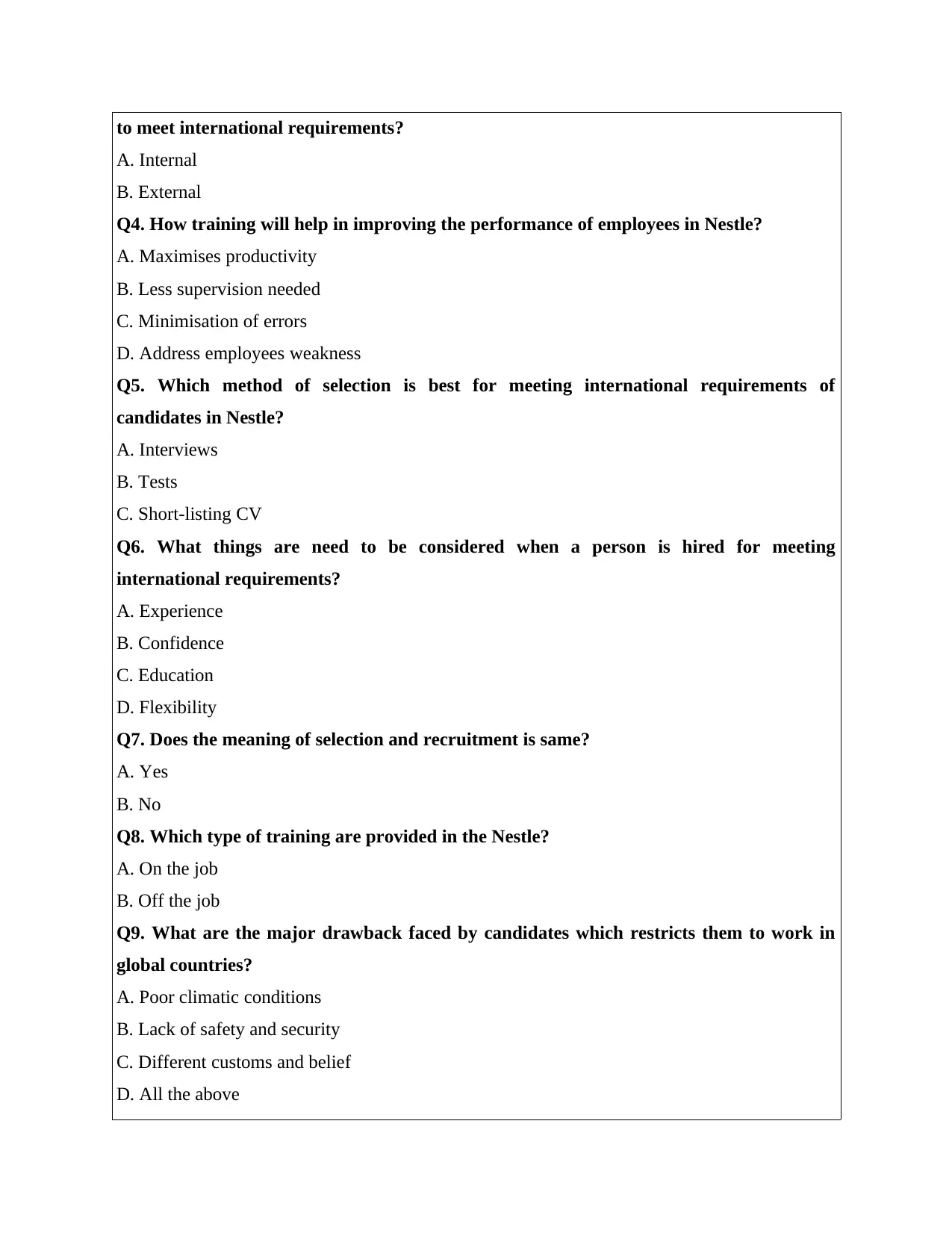
to meet international requirements?
A. Internal
B. External
Q4. How training will help in improving the performance of employees in Nestle?
A. Maximises productivity
B. Less supervision needed
C. Minimisation of errors
D. Address employees weakness
Q5. Which method of selection is best for meeting international requirements of
candidates in Nestle?
A. Interviews
B. Tests
C. Short-listing CV
Q6. What things are need to be considered when a person is hired for meeting
international requirements?
A. Experience
B. Confidence
C. Education
D. Flexibility
Q7. Does the meaning of selection and recruitment is same?
A. Yes
B. No
Q8. Which type of training are provided in the Nestle?
A. On the job
B. Off the job
Q9. What are the major drawback faced by candidates which restricts them to work in
global countries?
A. Poor climatic conditions
B. Lack of safety and security
C. Different customs and belief
D. All the above
A. Internal
B. External
Q4. How training will help in improving the performance of employees in Nestle?
A. Maximises productivity
B. Less supervision needed
C. Minimisation of errors
D. Address employees weakness
Q5. Which method of selection is best for meeting international requirements of
candidates in Nestle?
A. Interviews
B. Tests
C. Short-listing CV
Q6. What things are need to be considered when a person is hired for meeting
international requirements?
A. Experience
B. Confidence
C. Education
D. Flexibility
Q7. Does the meaning of selection and recruitment is same?
A. Yes
B. No
Q8. Which type of training are provided in the Nestle?
A. On the job
B. Off the job
Q9. What are the major drawback faced by candidates which restricts them to work in
global countries?
A. Poor climatic conditions
B. Lack of safety and security
C. Different customs and belief
D. All the above
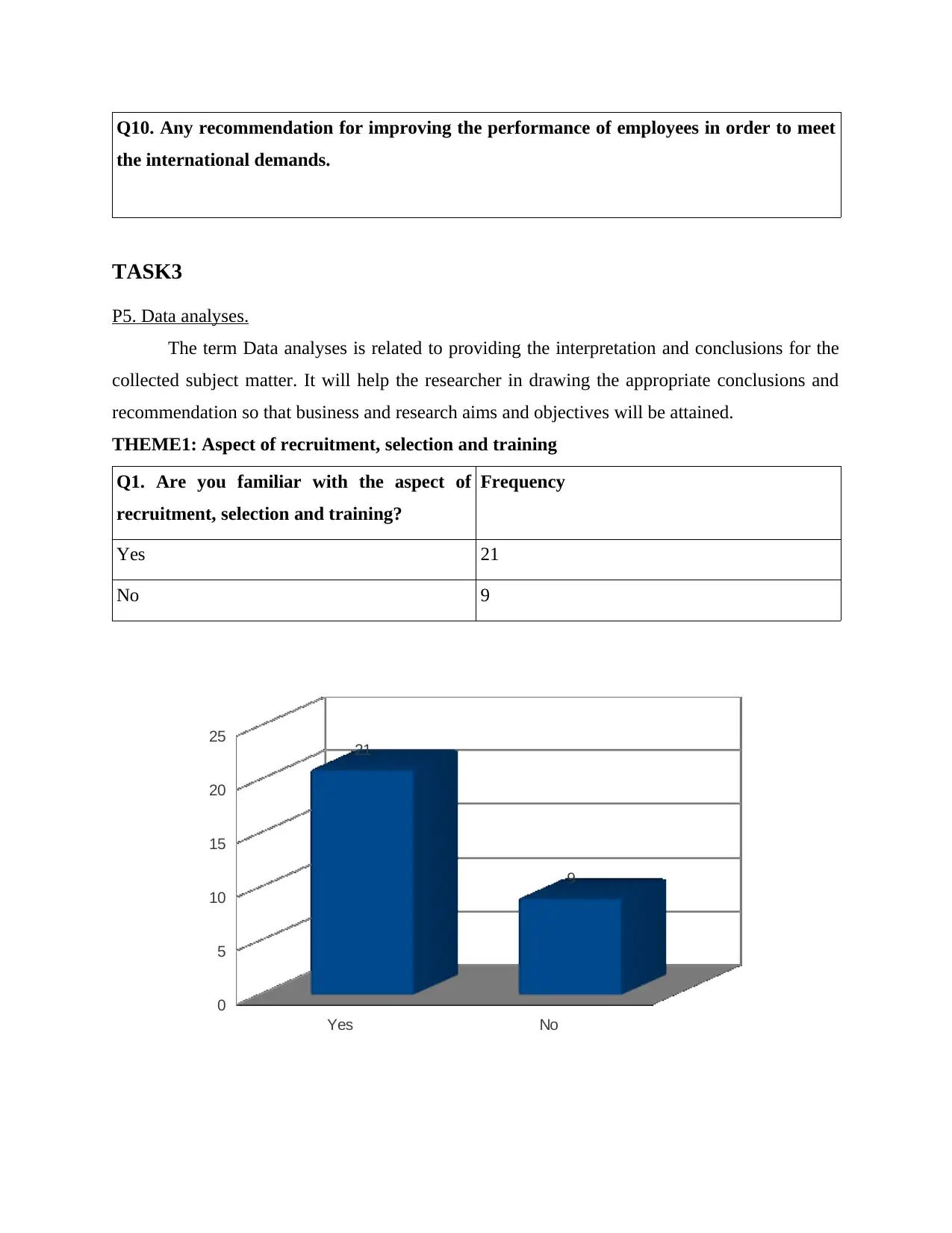
Q10. Any recommendation for improving the performance of employees in order to meet
the international demands.
TASK3
P5. Data analyses.
The term Data analyses is related to providing the interpretation and conclusions for the
collected subject matter. It will help the researcher in drawing the appropriate conclusions and
recommendation so that business and research aims and objectives will be attained.
THEME1: Aspect of recruitment, selection and training
Q1. Are you familiar with the aspect of
recruitment, selection and training?
Frequency
Yes 21
No 9
Yes No
0
5
10
15
20
25 21
9
the international demands.
TASK3
P5. Data analyses.
The term Data analyses is related to providing the interpretation and conclusions for the
collected subject matter. It will help the researcher in drawing the appropriate conclusions and
recommendation so that business and research aims and objectives will be attained.
THEME1: Aspect of recruitment, selection and training
Q1. Are you familiar with the aspect of
recruitment, selection and training?
Frequency
Yes 21
No 9
Yes No
0
5
10
15
20
25 21
9
⊘ This is a preview!⊘
Do you want full access?
Subscribe today to unlock all pages.

Trusted by 1+ million students worldwide
1 out of 32
Related Documents
Your All-in-One AI-Powered Toolkit for Academic Success.
+13062052269
info@desklib.com
Available 24*7 on WhatsApp / Email
![[object Object]](/_next/static/media/star-bottom.7253800d.svg)
Unlock your academic potential
Copyright © 2020–2025 A2Z Services. All Rights Reserved. Developed and managed by ZUCOL.





